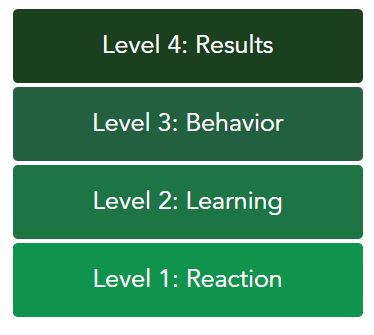What Is The Kirkpatrick Model at a Glance?
The Kirkpatrick Model is the gold standard for maximizing and validating talent investments. It’s being used by learning and development professionals all across the world for almost six decades.
Government, military, business, consultancy, services, and humanitarian sectors all benefit from our time-tested strategy. The model can be used in any program. Onboarding, product and program launches, leadership development, diversity, equality, and inclusion (DEI), safety, security, and succession planning are all popular themes for Kirkpatrick program assessment plans.
The model has never failed to work in any industry or software, which is a testament to its ageless, adaptable, and elegant design.
- Level 1: Reaction
- Level 2: Learning
- Level 3: Behavior
- Level 4: Results
Kirkpatrick’s Design
Reaction (Level 1)
The extent to which participants find the training beneficial, engaging, and applicable to their work.
Learning (Level 2)
The extent to which participants get the desired information, skills, attitude, confidence, and commitment as a result of their training participation.
Behavior (Level 3)
When participants return to work, how well they use what they learnt during training.
Results (Level 4)
The extent to which the training and support and accountability package deliver in the desired results
You need to know how effective your training was every time you give it to your staff. Are your employees applying what they’ve learned? Is it having a good impact on their role and the organization as a whole?
The Kirkpatrick Four-Level Training Evaluation Model might assist you in answering such queries. You can use it to objectively assess the impact of training, determine how well your team members learned, and make future learning improvements.
We’ll look at Kirkpatrick’s model and how to use it in this article. We’ll also think about when it wouldn’t be suitable.
In more detail – Kirkpatrick’s Four Levels of Understanding
Former University of Wisconsin Professor Emeritus Donald Kirkpatrick initially published his concept in 1959. He revised it in 1975 and again in 1993, when he released “Evaluating Training Programs,” his best-known book.
Each level of the model indicates a more exact assessment of a training program’s effectiveness. Donald and his son, James, worked on it further, followed by James and his wife, Wendy Kayser Kirkpatrick.
In their book “Four Levels of Training Evaluation,” published in 2016, James and Wendy expanded and clarified the original idea and presented the “New World Kirkpatrick Model.” One of the most significant additions is a focus on making training relevant to people’s regular work.
Reaction, Learning, Behavior, and Results are the four levels. Below, we take a closer look at each level and explain how to use it.
Reaction (Level 1)
You want them to think training is worthwhile. You can determine how well they got the instruction by measuring how engaged they were, how actively they contributed, and how they reacted to it.
It also allows you to create future program changes by highlighting essential themes that may have been overlooked.
Ask trainees the following questions:
- Did you consider the training to be worthwhile?
- Do you believe it was a success?
- What were the training’s main strengths and weaknesses?
- Did the location and presentation style appeal to you?
- Did the training session take into account your individual learning styles?
- Were the training exercises interesting?
- What are the three most essential lessons you took away from this course?
- What do you intend to do with what you’ve learned at your job?
- What kind of help would you need to put what you’ve learned into practice?
- Determine how you’ll gauge people’s reactions. Many people utilize employee satisfaction surveys to do this, but you can also study trainees’ body language or ask for vocal comments during the session.
Analyze the input and think about the modifications you could make as a result.
Learning (Level 2)
Level 2 focuses on determining what your learners have learnt and what they haven’t. Level 2 of the New World version of the tool also assesses what they believe they will be able to do differently as a result, their confidence in their ability to do so, and their motivation to make changes.
This illustrates how training has improved their confidence and commitment as well as their abilities, attitudes, and knowledge.
Begin by determining what you want to evaluate in order to determine how much your trainees have learnt. Make clear learning objectives your starting point when planning training sessions.
Depending on the goals, you can assess learning in a variety of methods. However, measuring these areas before and after training is beneficial.
Test your students before to the start of the course to establish their knowledge, skill levels, and attitudes. Then, after the training is over, retest your students to see what they’ve learnt, or assess their learning through interviews or verbal assessments.
Note: As a manager, you must keep employees accountable for improving their abilities and provide the necessary support.
Behavior (Level 3)
This level assists you in determining how successfully people put their training into practice. It can also show areas where people may want assistance. However, behavior can only change when the circumstances are good.
Assume you’re evaluating your team members following a training session. Because there is little evidence of learning, you infer that the training was ineffective.
It’s also possible that they learnt a lot but that the corporate or team culture prevents them from changing their behavior. Existing processes, for example, may limit the scope for implementing new ideas.
As a result, your employees lack confidence in their ability to apply new knowledge and perceive few opportunities to do so. It’s also possible that they didn’t have enough time to put it into practice.
Make careful to create systems that encourage, reinforce, and reward positive behavior improvements. These processes are referred to as “necessary drivers” in the New World Kirkpatrick Model. If a team member successfully employs a new ability, make a point of praising him or her.
Effective behavior measurement is a longer-term procedure that should occur weeks or months after the first instruction. Questions to consider are:
- Did the learners use what they had learned?
- Are trainees able to pass on their acquired skills, knowledge, or attitudes to others?
- Are the trainees aware that their behavior has changed?
- Conducting observations and interviews is one of the most effective approaches to assess behavior. Another option is to incorporate the usage of new abilities into the work you assign to your team, allowing employees to demonstrate what they know.
Managers should be heavily active at this level, assessing and advising their team members on how to modify their behavior.
Results (Level 4)
You assess the final results of your training at this level. This includes outcomes that you or your company have determined are good for business and good for your employees, as well as those that show a positive return on investment (ROI). (In certain customized versions of the paradigm, a Level 5 is dedicated to calculating ROI.)
The most expensive and time-consuming level will most likely be Level 4. The most difficult task will be determining which outcomes, advantages, or end results are most directly related to the training and devising an effective method for measuring these outcomes over time.
Modern trainers frequently reverse the Kirkpatrick model, expressing the desired outcomes first and then developing the training that is most likely to achieve them. This helps to prioritize the training’s objectives and improve its effectiveness.
Depending on the goals of your training, consider the following outcomes:
- Employee retention has improved.
- Production has increased.
- Morale is higher.
- Waste reduction.
- Sales have increased.
- Ratings of higher quality.
- Customer satisfaction has improved.
- Staff complaints are down.
Make a series of short-term observations and measures to ensure that behavioral changes resulting from training are improving your team’s performance. These are referred to as “leading indications” in the New World Kirkpatrick Model.
Tip: Make sure your training is well-planned. You can do this with the help of our articles Training Needs Assessment, Gagne’s Nine Levels of Learning, and 4MAT.
Kirkpatrick’s Model’s Potential Pitfalls
Kirkpatrick’s model is still widely utilized, although it should be approached with caution. Despite its many revisions, the basic structure is now more than 60 years old, and the ways that individuals learn and organizations operate have changed dramatically in that time. “Learning and development” has generally supplanted the term “training.”
Other, less formal kinds of job training are becoming increasingly popular and effective (as shown by the 70:20:10 model). And, as individualized, user-directed learning becomes more popular, conventional training is becoming less important. Kirkpatrick’s paradigm may not be appropriate for this new way of learning.
Another disadvantage is that Levels 3 and 4, which arguably provide the most important business information, are time-consuming, resource-intensive, and costly to execute. As a result, the model may not be appropriate for all businesses, particularly if you lack a specialized training or HR department to conduct the analysis. It’s also not appropriate for many situations, such as one-time instruction.
Most significantly, organizations evolve in a variety of ways, and these changes have an impact on behaviors, outcomes, and training. Rather than training, the entrance of a new boss or a new computer system could result in substantial gains in retention and production. It could also be a mix of these factors.
Kirkpatrick’s model is excellent for evaluating training in a “scientific” manner, but with so many variables, Level 4’s utility may be restricted.
The New World Kirkpatrick Model aims to solve some of these issues by pushing trainers and organizations to include evaluation in the training design process.
Important Points
The Kirkpatrick Four-Level Training Evaluation Model is intended to objectively assess training effectiveness. Donald Kirkpatrick designed the model in 1959, and it has undergone various revisions since then.
The four tiers are as follows:
- Reaction
- Learning
- Behavior
- Results
You can determine how effective a training initiative was and how to enhance it in the future by reviewing each level.
The methodology, however, isn’t appropriate for all scenarios, and measuring training efficacy with it can be time and resource-intensive, so it should be utilized with caution.





